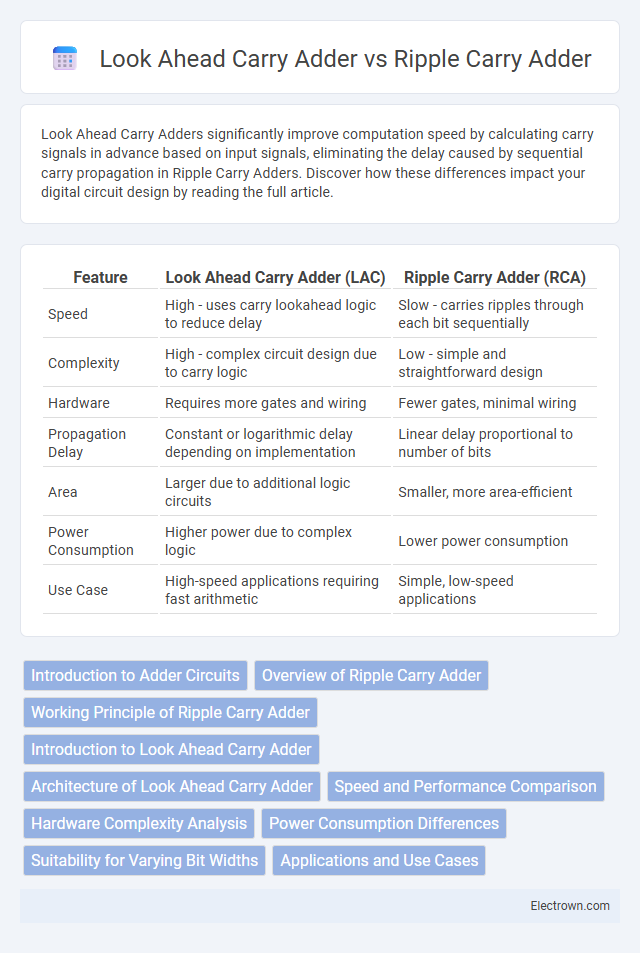Look Ahead Carry Adders significantly improve computation speed by calculating carry signals in advance based on input signals, eliminating the delay caused by sequential carry propagation in Ripple Carry Adders. Discover how these differences impact your digital circuit design by reading the full article.
Table of Comparison
| Feature | Look Ahead Carry Adder (LAC) | Ripple Carry Adder (RCA) |
|---|---|---|
| Speed | High - uses carry lookahead logic to reduce delay | Slow - carries ripples through each bit sequentially |
| Complexity | High - complex circuit design due to carry logic | Low - simple and straightforward design |
| Hardware | Requires more gates and wiring | Fewer gates, minimal wiring |
| Propagation Delay | Constant or logarithmic delay depending on implementation | Linear delay proportional to number of bits |
| Area | Larger due to additional logic circuits | Smaller, more area-efficient |
| Power Consumption | Higher power due to complex logic | Lower power consumption |
| Use Case | High-speed applications requiring fast arithmetic | Simple, low-speed applications |
Introduction to Adder Circuits
Adder circuits perform binary addition, fundamental in digital electronics and CPU arithmetic operations. A Ripple Carry Adder (RCA) connects each full adder's carry output to the next's carry input, resulting in slower propagation due to sequential carry processing. The Look Ahead Carry Adder (LCA) improves speed by computing carry signals in advance using generate and propagate functions, enhancing your system's overall performance.
Overview of Ripple Carry Adder
The Ripple Carry Adder (RCA) is a fundamental digital circuit used for binary addition, where each full adder's carry output directly feeds the next full adder's carry input, causing a sequential carry propagation. This architecture results in a simple design but introduces a delay proportional to the number of bits, known as carry propagation delay, which limits speed in large-bit adders. Despite its slower performance compared to the Look Ahead Carry Adder, the Ripple Carry Adder remains widely used in applications prioritizing simplicity and area efficiency.
Working Principle of Ripple Carry Adder
Ripple Carry Adder operates by connecting multiple full adders in series, where the carry output from each adder becomes the carry input for the next. This sequential propagation causes a delay proportional to the number of bits, as each carry must ripple through all preceding stages before the final sum is determined. Understanding this working principle is essential for evaluating your design's speed limitations compared to faster alternatives like the Look Ahead Carry Adder.
Introduction to Look Ahead Carry Adder
Look Ahead Carry Adder (LACA) improves addition speed by calculating carry signals in advance using generate and propagate functions, unlike Ripple Carry Adder (RCA), which waits for carry propagation sequentially. LACA reduces delay significantly in multi-bit binary addition by handling carry generation in parallel, optimizing arithmetic circuit performance. This parallelism makes LACA ideal for high-speed processors where rapid computation is critical.
Architecture of Look Ahead Carry Adder
The architecture of the Look Ahead Carry Adder (LCA) uses generate and propagate functions to calculate carry signals in advance, significantly reducing propagation delay compared to the Ripple Carry Adder (RCA). It employs parallel carry computation through dedicated look-ahead logic units, enabling simultaneous generation of carry bits for all adder stages. This design improves speed by eliminating the sequential carry dependency inherent in RCA architecture, making LCA highly suitable for high-speed arithmetic operations.
Speed and Performance Comparison
Look Ahead Carry Adders (LACAs) significantly outperform Ripple Carry Adders (RCAs) in speed due to their advanced carry prediction mechanism, which eliminates the cumulative delay caused by carry propagation in RCAs. While RCAs process each bit sequentially, resulting in slower computation times, LACAs calculate carry signals in parallel, enabling faster arithmetic operations, especially in high-bit-width additions. Your choice of adder can dramatically improve processing speed in applications demanding rapid and efficient binary addition.
Hardware Complexity Analysis
Look Ahead Carry Adders (LACA) drastically reduce propagation delay by generating carry signals in advance using complex logic circuitry, resulting in higher hardware complexity compared to Ripple Carry Adders (RCA). Ripple Carry Adders have a simpler design with a chain of full adders passing the carry sequentially, minimizing gate count but causing slower computation due to carry propagation. Your choice depends on balancing the critical trade-off between hardware resource expenditure in LACA and speed efficiency in RCA for specific digital circuit applications.
Power Consumption Differences
Look Ahead Carry Adders (LACAs) typically consume more power than Ripple Carry Adders (RCAs) due to increased circuit complexity and higher switching activity in carry lookahead logic. RCAs have simpler architecture with carry propagation through each bit, resulting in lower dynamic power consumption but slower speed. Your choice depends on balancing power efficiency and performance requirements in digital circuit design.
Suitability for Varying Bit Widths
Look Ahead Carry Adders are highly suitable for wider bit widths due to their ability to calculate carry signals in parallel, significantly reducing propagation delay. Ripple Carry Adders become less efficient as bit width increases since each bit's sum depends on the previous carry, causing delay to accumulate linearly. For small bit widths, Ripple Carry Adders are simpler and area-efficient, but Look Ahead Carry Adders provide superior performance in larger, high-speed applications.
Applications and Use Cases
Look Ahead Carry Adders excel in high-speed arithmetic operations, making them ideal for advanced processors, digital signal processing, and real-time computing systems where minimizing propagation delay is crucial. Ripple Carry Adders find common use in simpler, low-power applications such as embedded systems, microcontrollers, and educational tools, where circuit complexity and power consumption are prioritized over speed. Your choice between these adders depends on whether your project demands rapid computation or a more resource-efficient design.
Look Ahead Carry Adder vs Ripple Carry Adder Infographic

 electrown.com
electrown.com